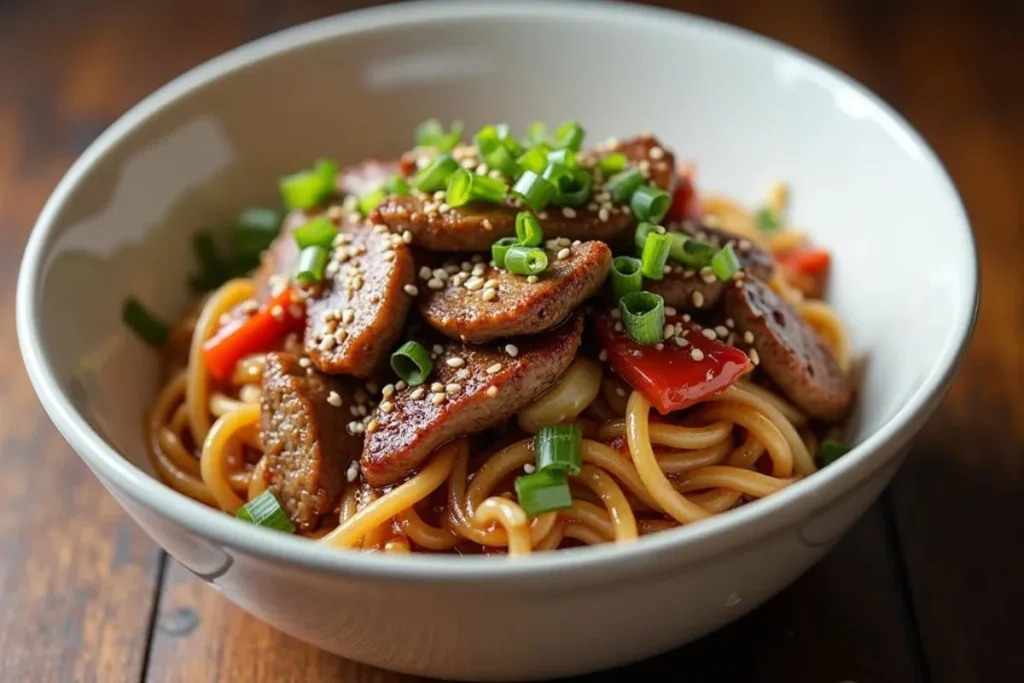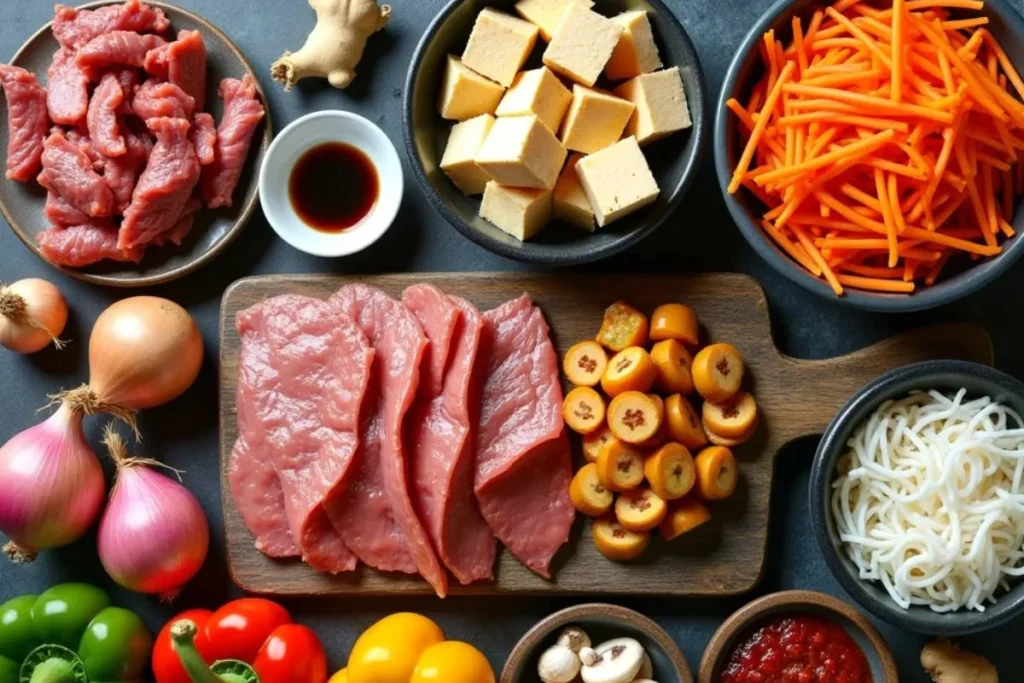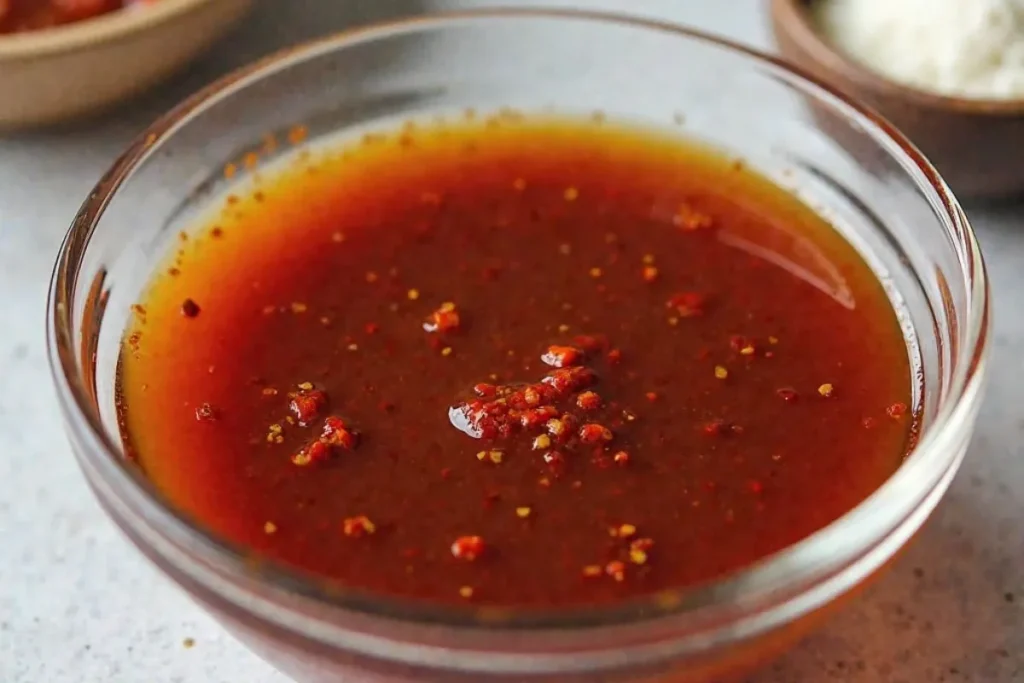Mongolian BBQ Recipe
Table of Contents
Introduction

Did you know that Mongolian BBQ isn’t actually from Mongolia? Despite the name, this popular stir-fry style originated in Taiwanese restaurants during the 1950s, quickly captivating the world with its sizzling, interactive cooking experience. If you’re looking for a dish that’s both easy to make and effortlessly customizable, then you’ll love this Mongolian BBQ recipe. Not only does it allow you to mix and match your favorite meats, vegetables, and sauces, but it also delivers a satisfying, healthy meal that’s perfect for busy weeknights or casual gatherings with friends.
By recreating this dish at home, you’ll save time, cut down on restaurant costs, and still get that irresistible blend of sweet, savory, and spicy flavors—all in one pan. Better yet, it’s surprisingly simple to master even if you’re new to stir-fry cooking. Ready to learn the tips, tricks, and secrets behind making an authentic Mongolian BBQ feast? Keep reading to discover how you can bring this sizzling sensation straight to your kitchen table.
What Is Mongolian BBQ?
Despite its name, Mongolian BBQ actually has roots in Taiwanese cuisine, where creative chefs first introduced this interactive stir-fry concept in the 1950s. The idea was to provide diners with a way to assemble their own bowls of thinly sliced meats, fresh vegetables, and bold sauces, then watch them sizzle on a flat-top grill. If you’ve ever tried a typical stir-fry before, you’ll notice some key differences in a Mongolian BBQ recipe:
- Customizable Bowls: Rather than following a strict list of ingredients, you pick and choose your favorites—chicken, beef, pork, tofu, or even shrimp.
- High-Heat Grilling: Traditional stir-fries often use a wok, but Mongolian BBQ takes place on a large, round grill, allowing multiple servings to cook simultaneously.
- Interactive Experience: Instead of just eating a pre-made dish, guests take part in designing their own flavor profile, making it a fun group activity.
Why It’s Unique
- Quick Cooking: The high heat and thin slicing ensure your food cooks in minutes, locking in flavor and texture.
- Endless Possibilities: You control the level of sweetness, spiciness, or saltiness by adjusting sauces like soy sauce, garlic oil, and chili paste.
- Great for Meal Prep: Portion out different proteins and veggies in advance, then cook as you need throughout the week.
Expert Tips & Common Mistakes
- Tip: Slice your meats as thinly as possible to ensure even cooking and tender texture.
- Tip: Prep all your vegetables and sauces beforehand—Mongolian BBQ comes together fast.
- Mistake: Overcrowding the grill or pan can cause steaming rather than searing, so cook in batches if needed.
Key Ingredients for Mongolian BBQ

When planning a Mongolian BBQ recipe, it helps to organize your ingredients into four main categories: proteins, vegetables, noodles or rice, and sauces or seasonings. Each component brings unique textures and flavors to the dish, and by mixing and matching, you can tailor your meal to personal tastes or dietary needs.
Proteins
- Beef (Flank or Sirloin): Slice thinly against the grain for quick, even cooking.
- Chicken (Breast or Thigh): Thighs provide extra moisture and a richer flavor, while breasts offer a leaner option.
- Pork (Loin or Tenderloin): Ideal for tender strips; avoid overly fatty cuts to prevent a greasy finish.
- Tofu (Extra-Firm): Press out water to maintain firmness, making it perfect for vegetarians or vegans.
- Seafood (Shrimp or Scallops): Quick to cook and pairs well with sweet, tangy sauces.
Expert Tip: Lightly marinate your protein in soy sauce, sesame oil, and a touch of cornstarch. This keeps meat tender and enhances the savory notes of your Mongolian BBQ recipe.
Common Mistake: Overcrowding the pan or grill, which leads to steaming instead of searing. Cook proteins in batches if necessary.
Vegetables
- Onions & Bell Peppers: These add a balance of sweetness and crunch.
- Carrots & Mushrooms: Carrots bring vibrant color; mushrooms contribute an earthy richness.
- Cabbage (Green or Napa): A budget-friendly option that soaks up the flavors of sauces.
- Other Favorites: Zucchini, bok choy, bean sprouts—feel free to experiment!
Expert Tip: Cut vegetables into uniform, bite-sized pieces so they cook evenly. If you like a crisp texture, add sturdier veggies (carrots, onions) first, then toss in softer ones (mushrooms, sprouts) toward the end.
Noodles or Rice
- Rice Noodles (Gluten-Free): Light and ideal for absorbing sauces without adding heaviness.
- Egg Noodles: A classic choice that complements the savory flavors of Mongolian BBQ.
- Steamed Rice: Simple, hearty base—perfect for soaking up extra sauce.
Expert Tip: Pre-cook and drain your noodles or rice. This prevents clumping and ensures they’re ready to be tossed into your stir-fry at the perfect moment.
Common Mistake: Leaving noodles in water too long, which can make them soggy. Pay close attention to the cooking times.
Sauces & Seasonings
- Soy Sauce (Low-Sodium or Tamari): Forms the salty, umami backbone of your stir-fry.
- Hoisin Sauce: Adds sweetness and depth; a little goes a long way.
- Sesame Oil: Imparts a nutty aroma—drizzle at the end to preserve flavor.
- Garlic & Ginger: Freshly minced for the best taste; they enhance any Mongolian BBQ recipe.
- Chili Paste or Flakes: Ideal for a spicy kick—adjust to your preferred heat level.
- Cornstarch (Slurry): Thickens the sauce, allowing it to coat each ingredient evenly.
Expert Tip: Whisk together your sauces before adding them to the wok or skillet. Taste-test and adjust for sweetness, saltiness, or spice to achieve the perfect balance.
Common Mistake: Adding too much sauce at once. Start small and increase gradually to avoid an overly salty or soupy stir-fry.
Dietary Needs & Substitutions
- Gluten-Free: Use tamari instead of soy sauce and opt for rice noodles or gluten-free egg noodles.
- Low Sodium: Choose low-sodium soy sauce, and reduce or eliminate additional salt in marinades.
- Vegan/Vegetarian: Replace meat with tofu, tempeh, or a medley of vegetables. Double-check that sauces like hoisin don’t contain animal products.
Equipment & Tools
When it comes to creating a flavorful Mongolian BBQ recipe at home, having the right tools not only streamlines the cooking process but also ensures optimal heat distribution and overall taste. Below are the essentials you’ll need before you begin stir-frying:
- Wok or Large Skillet (Cast-Iron or Stainless Steel)
- Designed to withstand high temperatures, allowing you to quickly sear proteins and vegetables.
- Offers a broad surface area for even cooking, preventing overcrowding.
- Cast-iron and stainless-steel options both deliver excellent heat retention; choose based on your personal preference.
- Metal Spatula or Wooden Spoon
- Durable enough to handle frequent stirring and flipping.
- Helps you scrape up any browned bits, enhancing the depth of flavor in your sauce.
- A long handle keeps your hands safely away from the sizzling heat.
- Bowls for Assembling and Serving
- Keep raw proteins, sliced vegetables, and cooked noodles neatly separated.
- Facilitate quick transitions from prep station to wok.
- Use additional bowls or platters for serving, making it easy for guests to assemble their own custom bowls.
With these basic tools on hand, you’ll be set to whip up a restaurant-quality Mongolian BBQ meal—no special gadgets required.
Making Mongolian BBQ at Home
There’s no need to trek to a specialty restaurant when you can recreate a mouthwatering Mongolian BBQ recipe in the comfort of your own kitchen. With just a few essential ingredients and tools, you’ll be able to capture the sizzling, savory flavors that make Mongolian BBQ so popular. Follow the detailed steps below for a consistently delicious result every time.
H3: Step 1 – Prepare Your Ingredients
- Slice Proteins & Chop Vegetables
- Proteins: Cut beef, chicken, pork, tofu, or shrimp into thin, uniform pieces. Thin slices ensure each piece cooks quickly and evenly. If using beef, choose a tender cut like flank steak or sirloin and slice against the grain. For chicken, thighs are more flavorful and juicy, but breasts work if you prefer leaner meat.
- Vegetables: Rinse and dry your selection of onions, bell peppers, carrots, mushrooms, or cabbage. Aim for similarly sized pieces to promote even cooking. Firmer veggies like carrots benefit from thinner slices, while softer veggies like mushrooms can be left slightly thicker to retain texture.
- Mix the Sauce
- Combine soy sauce (or tamari for a gluten-free option), hoisin, minced garlic, grated ginger, and a drizzle of sesame oil in a small bowl. This mixture will form the savory base of your stir-fry.
- If you enjoy a hint of sweetness, add a spoonful of brown sugar or honey. Prefer some heat? Stir in chili paste or a pinch of red pepper flakes.
- Whisk everything thoroughly to ensure the flavors blend well.
Pro Tip: For an extra depth of flavor, reserve a small amount of sauce to marinate your sliced protein for 10–15 minutes before cooking. This brief marination infuses the meat or tofu with robust, savory notes.
H3: Step 2 – Heat the Wok/Skillet
- Preheat on High
- Turn the heat on your stove to medium-high or high. A signature element of Mongolian BBQ is its quick cooking method, which relies on intense heat to sear and seal in flavors.
- Allow the wok or skillet to fully preheat—this usually takes a minute or two.
- Add Oil with a High Smoke Point
- Pour in just enough vegetable, canola, or peanut oil to coat the bottom of the pan lightly. These oils are well-suited for high-temperature cooking, ensuring your ingredients don’t burn too quickly.
- Wait until the oil shimmers—this indicates it’s hot enough to begin stir-frying.
Pro Tip: If you don’t have a wok, a wide, heavy-bottomed skillet (such as cast iron or stainless steel) can deliver comparable results. The key is to maintain consistent high heat.
H3: Step 3 – Cook Proteins
- Quick Stir-Fry
- Gently place your marinated proteins or tofu into the hot oil.
- Stir-fry for 2–3 minutes, ensuring each piece is in direct contact with the cooking surface. Constant movement helps you avoid uneven browning or scorching.
- Remove & Set Aside
- Once the proteins are just cooked through—no longer pink for meat, and lightly browned for tofu—transfer them to a clean bowl or plate.
- This step prevents overcooking, which can lead to dry, rubbery texture.
Common Mistake: Overcrowding the wok can cause steaming instead of searing. If you have a large quantity of protein, cook it in batches so each piece gets ample space to brown and crisp.
H3: Step 4 – Stir-Fry Vegetables
- Layer in Stages
- Begin with sturdier vegetables like carrots, onions, and bell peppers. Stir-fry these for about 2 minutes.
- Add softer veggies such as mushrooms, zucchini, or bean sprouts afterward, giving each type enough time to maintain its optimal texture.
- Maintain a Crisp-Tender Texture
- The beauty of Mongolian BBQ lies in the contrast of tender meats (or tofu) and crisp veggies. Keep your spatula moving to prevent burning.
- Aim for bright colors and a slight crunch—overcooking vegetables can make them limp and less appealing.
Pro Tip: Season the vegetables lightly with salt and pepper or a drizzle of soy sauce to build layers of flavor. However, avoid adding too much seasoning at this stage to prevent the final dish from becoming overly salty.
H3: Step 5 – Combine Everything
- Return Proteins to the Pan
- Once your veggies reach the desired level of doneness, add the cooked proteins back in.
- Give everything a quick toss to blend flavors.
- Add Noodles (If Using)
- If your Mongolian BBQ recipe includes noodles, such as egg noodles or rice noodles, gently fold them in now. They should be pre-cooked and drained to avoid excess moisture.
- Noodles absorb the sauce beautifully, so allow them to warm through for a minute or two.
- Pour in the Sauce
- Drizzle your prepared sauce over the combined ingredients. The heat will bring the sauce to a light simmer, allowing it to thicken slightly and coat each piece evenly.
- If you prefer a thicker sauce, mix 1 teaspoon cornstarch with 1 tablespoon water to create a slurry. Stir this into the pan and watch as the sauce quickly thickens.
Pro Tip: Continuously stir the ingredients while the sauce reduces to prevent burning. The sauce should be glossy and cling to the meat, veggies, and noodles without pooling at the bottom.
H3: Step 6 – Adjust & Serve
- Taste & Tweak
- Sample a small bite. Need more salt? Add a dash of soy sauce. Craving extra heat? Sprinkle in chili flakes or drizzle some sriracha.
- Adjusting at the end helps you achieve the perfect flavor balance.
- Garnish
- Finish your Mongolian BBQ with a scattering of sliced green onions, sesame seeds, or even fresh cilantro.
- For an extra spicy twist, drizzle chili oil or top with sliced jalapeños.
- Serve Immediately
- Transfer everything to a serving dish or individual bowls.
- Enjoy your piping hot stir-fry with steamed rice, extra noodles, or by itself.
Pro Tip: Mongolian BBQ is best served fresh off the heat, so encourage diners to dig in right away. If preparing multiple batches, you can keep cooked portions warm in a low oven (around 200°F or 93°C) while you finish the rest.
Mongolian BBQ Sauce Recipe (Optional Detailed Section)

While you can certainly use a pre-made stir-fry sauce in your Mongolian BBQ recipe, crafting your own sauce from scratch allows you to fine-tune the balance of sweet, savory, and spicy flavors. Below is a detailed breakdown of the essential ingredients, along with tips on how to combine them for the perfect finishing touch.
Key Sauce Ingredients
- Soy Sauce (Low Sodium vs. Regular)
- Why It’s Important: Soy sauce provides the foundational umami flavor in Mongolian BBQ sauce.
- Low Sodium vs. Regular: If you’re watching your salt intake, opt for a low-sodium version. For those who prefer a bolder, saltier taste, standard soy sauce is fine.
- Usage Tip: Start with a moderate amount and taste-test as you go. It’s easier to add more soy sauce later than to correct an overly salty sauce.
- Hoisin Sauce
- Flavor Profile: Hoisin offers sweetness with a slight smokiness, creating depth and balance.
- Consistency: Its thicker texture helps coat noodles, proteins, and vegetables evenly.
- Usage Tip: If you find hoisin too sweet, counterbalance it with an extra splash of soy sauce or a dash of rice vinegar.
- Sesame Oil
- Aromatic Element: Sesame oil brings a toasted, nutty aroma that elevates the entire dish.
- Concentrated Flavor: A little goes a long way; adding too much can overpower other flavors.
- Usage Tip: Stir in sesame oil at the end of cooking to preserve its fragrant qualities.
- Minced Garlic & Ginger
- Essential Aromatics: Freshly minced garlic and ginger are signature flavors in many Asian-inspired sauces. They add zing and help balance sweetness.
- Preparation: Peel and mince or grate ginger to release more flavor. For garlic, use a fine mince or a press for best results.
- Usage Tip: Briefly sauté garlic and ginger in hot oil before blending with other sauce ingredients for a richer, caramelized flavor.
- Chili Sauce or Chili Flakes
- Spice Level: Adjust the heat by adding more or less chili paste (like sambal oelek) or chili flakes.
- Flavor Boost: A hint of spice can sharpen the sweetness from hoisin sauce, resulting in a well-rounded taste.
- Usage Tip: Start with a small amount, then gradually increase until you reach your preferred heat level.
- Cornstarch Slurry for Thickening
- Purpose: A simple mixture of 1 tablespoon cornstarch and 1–2 tablespoons water helps create a glossy, clingy texture.
- How to Use: Whisk the slurry into your sauce once it’s heated and simmering. Stir continuously to prevent lumps.
- Usage Tip: Go slow—adding too much slurry at once can make the sauce overly thick or even gelatinous.
Combining the Ingredients
- Measure & Mix
- In a small bowl or measuring cup, combine your soy sauce, hoisin sauce, a drizzle of sesame oil, and a spoonful of minced garlic and ginger.
- Stir in your chili sauce or flakes, tasting as you go to gauge spiciness.
- Heat & Simmer
- Transfer the mixture to a small saucepan over medium heat or pour it directly into the wok once your proteins and vegetables are partially cooked.
- Let the sauce come to a light simmer, allowing flavors to meld together.
- Thicken with Cornstarch Slurry (Optional)
- If you want a velvety, restaurant-style consistency, whisk the cornstarch slurry into the simmering sauce.
- Stir constantly for 1–2 minutes until the sauce thickens and coats the back of a spoon.
- Taste & Adjust
- Sample the sauce. If it’s too salty, add a splash of water or a hint of sweetness (honey, brown sugar). Too sweet? Add a dash more soy sauce or a little rice vinegar.
- Keep tweaking until you achieve the perfect harmony of flavors.
Pro Tips & Variations
- Balance Is Key: Every palate is different, so don’t be afraid to experiment with ratios. More hoisin for sweetness, more soy sauce for savoriness, or more chili for heat.
- Dietary Adaptations:
- Gluten-Free: Swap soy sauce for tamari or coconut aminos.
- Sugar-Free: Avoid hoisin or sweeteners; rely on garlic, ginger, and chili for flavor.
- Storage: You can make the sauce in advance and store it in the fridge for up to a week. Warm it gently before using in your Mongolian BBQ recipe.
Variations & Serving Suggestions
One of the best things about a Mongolian BBQ recipe is its versatility. Whether you have dietary restrictions or simply prefer different flavor profiles, you can easily tailor your stir-fry to match your tastes. Below are some creative variations and serving ideas to inspire your next meal.
Vegetarian/Vegan
- Swap Out the Meat: Replace beef, chicken, or pork with tofu or tempeh. Press tofu beforehand to remove excess moisture and enhance its ability to soak up sauces.
- Use Vegetarian Sauces: Opt for vegetarian oyster sauce (made from mushrooms) or a savory hoisin–soy blend instead of traditional oyster sauce.
- Boost Flavor: Add extra ginger, garlic, or chili sauce to make up for the savory notes that typically come from meat-based proteins.
Pro Tip: For a hearty texture, try incorporating sliced mushrooms or eggplant, both of which soak up the sauce beautifully.
Low-Carb/Keto
- Skip the Noodles: Keep things keto-friendly by omitting starches like rice or egg noodles.
- Use Veggie Alternatives: Spiralized zucchini noodles (zoodles), cauliflower rice, or thinly sliced cabbage can replace traditional grains and noodles.
- Mind Your Sauces: Check labels for hidden sugars in hoisin sauce or sweetened chili sauce; reduce or skip these if you’re counting carbs. Instead, focus on soy sauce or tamari, fresh aromatics (garlic, ginger), and a splash of sesame oil.
Pro Tip: Adding extra proteins or fibrous veggies like bok choy and broccoli can make your keto version more filling without upping the carb count.
Extra Spicy
- Chili Paste & Fresh Peppers: Stir in sambal oelek, gochujang, or sriracha for a fiery punch. Alternatively, thinly slice fresh peppers—like jalapeños or Thai chilies—to sauté alongside your proteins and veggies.
- Spice Layers: Season the protein with chili flakes, then amp up the heat again with a spicy sauce. This ensures each bite packs a punch.
- Balance is Key: To keep the dish from becoming overwhelmingly hot, offset the spice with a touch of sweetness or add creamy elements like coconut milk or peanut butter.
Pro Tip: Let your dinner guests customize their own heat levels by serving extra chili paste or sliced peppers on the side.
Serving Ideas
- Over Steamed Rice
- Keep it simple by spooning your stir-fry over a bed of fluffy white or brown rice. The rice absorbs any extra sauce, making each bite more flavorful.
- With Noodles
- If you haven’t already stirred noodles into the wok, serve your Mongolian BBQ on top of lo mein, egg noodles, or rice noodles. This approach is perfect for those craving a heartier meal.
- On the Side
- Egg Rolls: Crispy, savory egg rolls complement the stir-fry’s tenderness and add an extra layer of crunch.
- Cucumber Salad: A light and refreshing choice to balance out the rich flavors of Mongolian BBQ. Simply toss thinly sliced cucumbers with rice vinegar, a pinch of sugar, and chili flakes for a quick side dish.
Frequently Asked Questions (FAQ)
Below are some of the most common inquiries readers have about perfecting a Mongolian BBQ recipe at home. Whether you’re wondering about storage, cooking techniques, or choosing the right ingredients, these answers will help you fine-tune your stir-fry experience.
Q: Can I make this in advance?
A: Mongolian BBQ is best enjoyed fresh off the wok, but you can absolutely prepare certain components ahead of time. For instance, slice and marinate your proteins, chop the vegetables, and mix the sauce up to a day before cooking. Store them separately in airtight containers in the refrigerator, then stir-fry when you’re ready to serve. This method keeps the final dish quick and convenient without sacrificing flavor or texture.
Q: Which cut of meat works best?
A: Flank steak, sirloin, or ribeye are popular beef choices due to their tenderness and quick cooking time. For poultry, chicken thighs are juicier and more forgiving if slightly overcooked, while chicken breasts are leaner and cook faster. If you prefer pork, opt for tenderloin or thinly sliced pork loin. Whichever protein you choose, be sure to slice it thinly and against the grain for maximum tenderness.
Q: How do I get that “restaurant-style” char?
A: High heat and minimal crowding are key. Make sure your wok or skillet is thoroughly preheated before adding oil and ingredients. Cook proteins and vegetables in smaller batches to prevent steaming. Stir frequently, but allow the edges of the meat and veggies to sear for a few seconds at a time. This creates those coveted caramelized spots reminiscent of restaurant-quality Mongolian BBQ.
Q: Can I freeze leftovers?
A: Yes. Once fully cooled, transfer leftovers to an airtight container or freezer-safe bag. They’ll keep for up to three months. To reheat, thaw overnight in the refrigerator, then warm gently in a hot skillet with a splash of oil or fresh sauce. Keep in mind that the texture of vegetables may soften slightly after freezing, but the flavors will remain delicious.
Final Thoughts
We hope this guide helps you confidently recreate an authentic Mongolian BBQ recipe in your own kitchen. The beauty of Mongolian BBQ lies in its adaptability—there’s always room to switch up proteins, veggies, sauces, or even cooking methods to suit your preferences and dietary needs. Did you discover an unexpected combination of flavors? Found a new sauce ingredient that took your stir-fry to the next level? We’d love to hear about it!
Feel free to leave a comment or review below to share your experience, ask questions, or suggest new twists you’ve tried. If you post your culinary creations on social media, remember to tag us so we can see—and celebrate—your homemade Mongolian BBQ masterpiece. We’re always excited to see how you customize the recipe, and your feedback can inspire future variations for other readers as well. Happy cooking, and enjoy your next sizzling stir-fry adventure!

